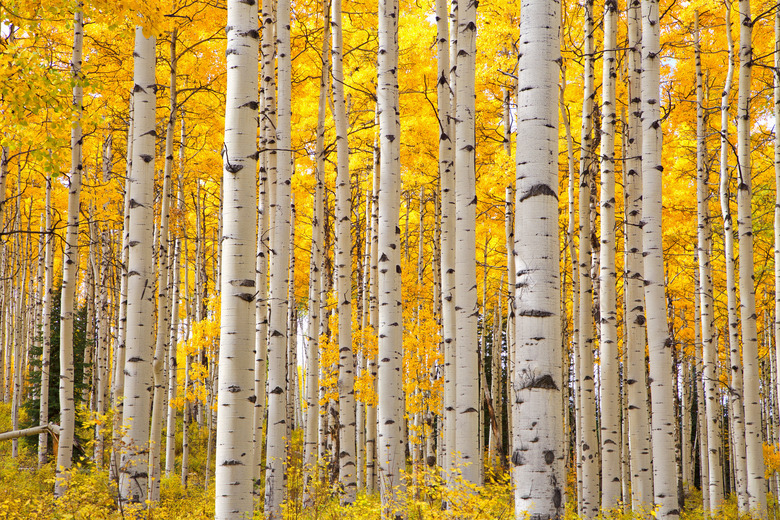Diseases Of Aspen Trees
Aspen trees (Populus spp.) are prone to many diseases, according to the Missouri Botanical Garden. Most of these diseases are caused by fungi. Because their bark is relatively weak, aspen trees (Populus spp.) are prone to injuries. These injured spots and damage by aspen tree borers allow fungal pathogens to enter and infect the tree. Most diseases, if caught early enough, will not permanently affect the tree.
Aspen Cytospora Canker Disease
Cytospora canker is a fungal disease caused by several species of fungi belonging to the Cytospora genus. It can affect more than 70 species of trees, including aspens. Symptoms of this disease include discolored areas on the bark that are yellow, orange-brown or black in color; twig and branch dieback; liquid, orange-colored ooze in the spring; sunken dead areas of bark with black pimples or speckling; and reddish brown discoloration on the wood and/or inner bark.
The black pimples are reproductive structures of the fungus. During wet conditions, long orange threads or spores may ooze out of the pimples. Symptoms will increase each year as the disease progresses. Drought, late spring frosts, defoliation, herbicides, injury and sunscald make aspen trees more susceptible to this disease.
Aspen Leaf Fungus
Aspen leaf spot is also called Marssonina leaf spot, after the Marssonina fungal pathogen that causes the disease. It is the most common foliar disease among aspen and cottonwoods in Colorado according to W. R. Jacobi, a bioagricultural sciences professor at Colorado State University.
Symptoms of aspen leaf spot are dark brown or black flecks with either yellow halos or white centers on the leaves, but leaf petioles and terminal shoots may also be affected. These spots may merge to form large black patches on the leaves. Aspen leaves turning black may be scattered throughout the tree instead of concentrated in one spot. Symptoms usually start to appear between July and the first fall frost. Although this disease is not usually damaging, it can cause early leaf drop if a tree is heavily infested.
Aspen Ink Spot
Ink spot is another fungal disease, this time caused by the pathogen Ciborinia. Symptoms include dark brown or black raised oval spots about 1/4-inch long on the leaves, which may eventually cause holes when the areas fall out. Infected leaves may die while uninfected leaves remain green. This disease can cause early leaf drop and reduce tree growth. Ink spot is common in the mountains of Colorado and in dense aspen stands.
Aspen Rust Disease
Rust disease is caused by the fungal pathogen Melampsora. It causes small, yellowish-orange, swollen spots on the back side of the leaves. When broken open, these spots release an orange liquid or powder. Spots are most visible in the late summer and early fall.
This disease can multiply rapidly during wet conditions. Although common, it rarely causes major problems. However, several years of serious infections can cause growth loss in younger trees.
Aspen Leaf and Shoot Blight
Leaf and shoot blight is caused by the fungal pathogen Venturia. It primarily affects young aspen and cottonwood. Symptoms first appear in the spring when irregular brown or black shapes appear on the leaves. Within a few days, the darkened tissue will turn olive green and then cause the leaves to dry or become distorted. It will also cause cankers on new shoots that cause the stem to blacken and curl, resulting in distorted, shrubby growth.
Other Aspen Diseases
A few other diseases that can affect aspen include black canker, sooty bark canker and snake canker. Black canker is caused by the fungal pathogen Ceratocystis fimbriata. It causes a large circular canker with layers of black bark or tissue. Because it develops slowly, it is rarely lethal.
Sooty bark canker is caused by the fungal pathogens Encoelia pruinosa or Cenangium singulare. It appears as dark sunken areas on the bark. Bark eventually peels away in strips to reveal a black inner wood. Because it spreads rapidly, it can be quite deadly.
Snake canker is caused by the fungal pathogen Cryptosphaeria populina. It gets its name because it causes long, spiraling grayish depressions that circle the branches and tree that can be several feet long. Depressions eventually decay and kill the tree within a few years.
